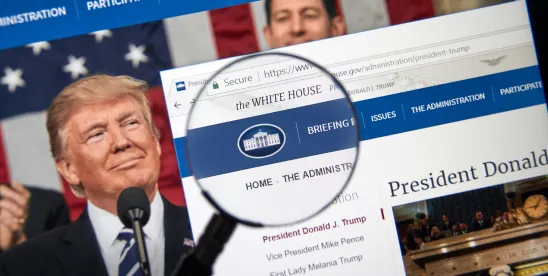President Donald Trump has made reducing the size and scope of the federal government a central part of his second-term agenda. Toward that end, in recent days the Trump administration has taken aggressive steps toward rescinding federal regulations it deemed unnecessary, unlawful, unduly burdensome, or unsound. As discussed below, these steps will present opportunities for some, costs for others, and will test the bounds of the President’s authority to control and direct the administrative state.
Decisions to deregulate will disparately affect stakeholders. For some, deregulation will be a welcome reprieve from unfavorable rules. For others, however, the loss of regulations will cast considerable uncertainty over significant investment and business decisions. Reflecting the Administration’s objective to deregulate, executive orders and other actions include multiple options for the public to identify regulations that should be rescinded or replaced but no comparable options to identify regulations that should be retained. The Administration’s pronouncements also suggest that it will pursue multiple paths for deregulation, including some without direct public input.
The process to deregulate will vary, depending on the issue and the agency. In some situations, it appears that typical Administrative Procedure Act (APA) notice-and-comment procedures will be followed, which take more time and solicit public input, both to oppose regulations and to offer support, depending on the interest of the stakeholder. But in other situations, it appears that the decision to rescind some rules may be made quickly and without notice. In all cases, no matter the issue or the agency, it will be important to remain vigilant over the coming weeks and months to monitor the fate of regulations important to you and your business. Against the backdrop of the President’s promise to shrink federal bureaucracy, the Administration has taken several steps to significantly reduce the regulatory footprint.
A Chronology of the Developing Deregulatory Agenda
Unleashing Prosperity Through Deregulation, Executive Order 14192, 31 January 2025
Orders that 10 existing regulations be eliminated for each new regulation. For purposes of this executive order, the term “regulation” or “rule” may include subregulatory guidance.
Ensuring Lawful Governance and Implementing the President’s “Department of Government Efficiency” Deregulatory Initiative, Executive Order 14219, 19 February 2025
Orders agency heads to report within 60 days regulations under their jurisdiction that they deem are unlawful, unconstitutional, not the best interpretation of the statute, harmful to the national interest, unduly burdensome to small businesses, or that meet similar criteria.
Directing the Repeal of Unlawful Regulations, White House Memorandum, 9 April 2025
Further implements Executive Order 14219 to direct agency heads to prioritize regulations that violate a series of Supreme Court cases, including Loper Bright Enterprises v. Raimondo, 603 U.S. 369 (2024), West Virginia v. EPA, 597 U.S. 697 (2022), and eight others. Authorizes agency heads to rescind regulations without notice and comment, where doing so is consistent with the “good cause” exception in the APA. The good cause exception applies when the APA notice-and-comment process would be “impracticable, unnecessary, or contrary to the public interest.”
Zero-Based Regulatory Budgeting to Unleash American Energy, Executive Order 14270, 9 April 2025
Directs 10 energy and environment-focused federal agencies to incorporate a one-year sunset provision into existing covered regulations governing energy production by 30 September 2025 and a five-year sunset provision into new covered regulations.
Request for Information: Deregulation; Office of Management and Budget, 11 April 2025
Requests public comment on regulations that are unnecessary, unlawful, unduly burdensome, or unsound, with an emphasis on regulations that are inconsistent with statutory text or the Constitution, where burdens exceed benefits, or meet other criteria. Comments are due on 12 May 2025.
Deregulation Suggestions; General Services Administration Adds New Page to regulations.gov/deregulation
A template format requesting public input on ideas for cutting existing rules or regulations. Requests the background of the regulation and an explanation of why it should be rescinded.
Public Recommendations Invited on Items to be Included on the 2025-2026 Priority Guidance Plan; Internal Revenue Service (IRS) Notice 2025-19
Requests public input on regulatory projects to be prioritized by the IRS, focusing on regulations meeting the criteria of Executive Order 14219.
A Menu of Mechanisms to Rescind Regulations
Historically, traditional APA notice-and-comment rulemaking has provided the primary means of issuing and rescinding regulations. However, the actions outlined above indicate that the Trump Administration will be looking to use a much broader toolkit to effectuate its deregulatory agenda, including interim final rules, direct final rules, and enforcement discretion. These other mechanisms involve varying levels of public participation. For example, the Administration issued an interim final rule to rescind all of the Council on Environmental Quality’s implementing regulations for the National Environmental Policy Act, enabling the rescission to go into effect while allowing notice and comment after the fact to potentially inform a final rule.1 On the other hand, the Administration has also invoked the APA’s “good cause” exception as a basis for issuing direct final rules with no notice and comment, including where the President himself has—more controversially—simply ordered the repeal.2 Beyond these formal mechanisms, the Administration has pressed enforcement discretion as a means of effective repeal, including through conditional sunset provisions and categorically ceasing investigative and enforcement efforts under certain regulations.3
Although unanswered questions remain about specific processes and procedures, as well as the timeline to deregulate, the recent deregulatory measures demonstrate the magnitude and the direction of Trump administration efforts to reduce the regulatory footprint. Stakeholders who want certain regulations to be repealed should seriously consider availing themselves of the opportunity to provide suggestions given the 10-1 ratio of rescissions to new rules. Likewise, stakeholders with an interest in keeping regulations in place should utilize opportunities arising from the APA notice-and-comment process to provide that input. Now is not the time to sit on the sidelines.
The firm's Policy and Regulatory team is closely monitoring updates in this area and stand ready to help you navigate the rapidly changing regulatory environment.









 />i
/>i
